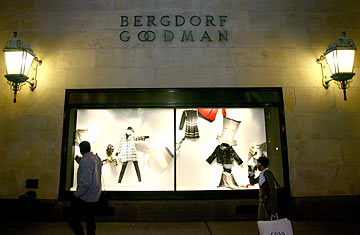
Bergdorf Goodman
If you want to hazard a guess at which luxury brand might be next to stumble, take a quick spin around the second or third floors of New York City's Bergdorf Goodman department store. There you will find racks upon racks — sometimes, entire collections — of designs by Marc Jacobs, Chanel, Dior, Armani, Thakoon and Alberta Ferretti marked down 40%. What's impressive is not only the steep markdowns, but also the sheer volume of merchandise that remains. In some cases, every size of a silhouette is still available, indicating that not a single shopper bought the look.
The typical luxury consumer has traded in high-priced fashion for quality, durable goods at a lower price, according to a recent report by Bain & Company. As a result, the luxury market is expected to shrink by 10% in 2009, with apparel being hit the hardest. So, when French couturier Christian Lacroix filed for court protection from creditors (similar to Chapter 11 bankruptcy protection in the United States) on May 28, it came as no surprise — especially since the filing was timed to same-store sales comps for May, which for department stores like Neiman Marcus and Saks Fifth Avenue were down a whopping 27% and 26.6%, respectively. (See pictures of retailers which have gone out of business.)
Lacroix's chief executive, Nicolas Topiol indicated that the brand would continue, despite this setback. "Since the acquisition of Christian Lacroix SNC, we have been committed to the brand and to its high-end development," Topiol said in a statement. "We will continue to do so, but the sharp downturn of the luxury market has significantly hurt our revenues."
But Lacroix's situation is indicative of the state of luxury overall, a business that is structured on a pyramid model wherein companies invest in the high-end image of a brand that will generate profits at the lower end of the price spectrum. Lacroix, who launched his label in 1987 with the financial backing of Bernard Arnault, chief of the mighty LVMH Moët Hennessy Louis Vuitton, is a product of a 20-year creative and business cycle that has come crashing down with the recent global financial crisis. Despite his enormous creativity and influence on fashion, Lacroix could never turn a profit. Many of the press reports on the house's failures blamed the designer's underperforming stores in New York City and Las Vegas. But at the heart of the Lacroix saga is an unsuccessful perfume launch that dates back to 1990, and his continuing inability to translate his unique high-end fashion flair into more accessible products, like fragrance, lipstick and accessories. As a result, Arnault sold the brand in 2005 to the Falic Group, a Florida-based business known for its Duty Free Americas chain. (See pictures of very large diamonds at LIFE.com.)
Lacroix is not the only fashion house to teeter on the brink. The Antwerp-based designer Veronique Branquinho closed her business last week, blaming the dismal financial situation. Meanwhile, economic pressures are straining relationships inside famous luxury brands. Versace S.p.A. announced on Friday that Giancarlo Di Risio, the house's well-regarded chief executive officer since 2004, will step down. No official reason was given, but sources say that clashes over expenses with Donatella Versace, the creative director and part owner of the brand, were to blame. Another CEO, Kim Winser of the British brand Aquascutum, also resigned last week, after a buyout she put together was rejected by the brand's Japanese parent company, Renown. And according to a report in Women's Wear Daily, Ungaro designer Esteban Cortezar is expected to leave the house after just three seasons, following disagreements with CEO Mounir Moufarrige. The good news for opportunistic Bergdorf shoppers? Maybe even deeper discounts on Floor Two in the fall.
See pictures of the evolution of the mini skirt at LIFE.com.
